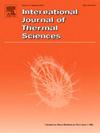Thermo-fluids performance analysis and experimental verification of topologically optimized mini-channel heat sinks integrated with impact jet
IF 4.9
2区 工程技术
Q1 ENGINEERING, MECHANICAL
International Journal of Thermal Sciences
Pub Date : 2025-01-13
DOI:10.1016/j.ijthermalsci.2025.109705
引用次数: 0
Abstract
Mini/micro-channel heat sinks with integrated impact jet offer significant potential for enhanced heat transfer performance. In this work, jet structures are integrated with four-inlet-two-outlet horizontal-flow heat sinks and the thermo-fluids performance is discussed. At first, four horizontal-flow heat sinks with diverse distributions of inlets and outlets locations are designed, using variable density topology optimization method with the minimization of average temperature and pressure drop as optimization objective. Among them, three are symmetric structures and one is asymmetric. Numerical simulations are conducted on the thermo-fluids performance of these four designs across six channel heights . The designs of MHS-A and MHS-B exhibit the highest cooling efficiency factor and best flow performance, respectively. In addition, the comprehensive performance evaluation of the asymmetric structure MHS-D is not the worst. Subsequently, a jet structure was integrated above the original horizontal flow path so that the vertically oriented fluid impinges on the horizontal flow path, forming the new cross-flow radiators IJMHS-A and IJMHS-B. Numerical results indicate that at a volume flow rate of 1152 ml/min and a jet ratio of 20 %, the average temperatures, maximum temperatures and temperature differences of IJMHS-A and IJMHS-B are reduced by 4.8 K, 6.8 K, 3.7K and 7.6 K, 10.8 K, 7.3K, respectively. A slight pressure drop loss is observed only for . The jet's gain of thermal performance decreases with increasing volume flow rate, displaying boundary effects. As the jet flow ratio rises, thermal performance initially improves, then declines, while the pressure drop increases at an accelerated rate. Optimal interval of the jet flow ratio is structure-dependent. For IJMHS-A and IJMHS-B, the best performance occurs with a jet flow ratio between 10 % and 30 %, combining benefits of both horizontal-flow topology and jet-flow structures. As the jet ratio continues to rise, the flow shifts from horizontal to jet characteristics, rapidly degrading heat transfer and flow performance. Numerical simulations are verified, aligning well with experimental results.
求助全文
约1分钟内获得全文
求助全文
来源期刊

International Journal of Thermal Sciences
工程技术-工程:机械
CiteScore
8.10
自引率
11.10%
发文量
531
审稿时长
55 days
期刊介绍:
The International Journal of Thermal Sciences is a journal devoted to the publication of fundamental studies on the physics of transfer processes in general, with an emphasis on thermal aspects and also applied research on various processes, energy systems and the environment. Articles are published in English and French, and are subject to peer review.
The fundamental subjects considered within the scope of the journal are:
* Heat and relevant mass transfer at all scales (nano, micro and macro) and in all types of material (heterogeneous, composites, biological,...) and fluid flow
* Forced, natural or mixed convection in reactive or non-reactive media
* Single or multi–phase fluid flow with or without phase change
* Near–and far–field radiative heat transfer
* Combined modes of heat transfer in complex systems (for example, plasmas, biological, geological,...)
* Multiscale modelling
The applied research topics include:
* Heat exchangers, heat pipes, cooling processes
* Transport phenomena taking place in industrial processes (chemical, food and agricultural, metallurgical, space and aeronautical, automobile industries)
* Nano–and micro–technology for energy, space, biosystems and devices
* Heat transport analysis in advanced systems
* Impact of energy–related processes on environment, and emerging energy systems
The study of thermophysical properties of materials and fluids, thermal measurement techniques, inverse methods, and the developments of experimental methods are within the scope of the International Journal of Thermal Sciences which also covers the modelling, and numerical methods applied to thermal transfer.
 求助内容:
求助内容: 应助结果提醒方式:
应助结果提醒方式:


